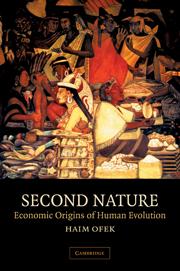Book contents
- Frontmatter
- Contents
- Acknowledgments
- 1 Introduction
- Part 1 Bioeconomics
- Part 2 Paleoeconomics
- 8 Departure from the feed-as-you-go strategy
- 9 The origins of market exchange
- 10 Domestication of fire in relation to market exchange
- 11 The Upper Paleolithic and other creative explosions
- 12 Transition to agriculture: the limiting factor
- 13 Transition to agriculture: the facilitating factor
- References
- Index
13 - Transition to agriculture: the facilitating factor
Published online by Cambridge University Press: 06 July 2010
- Frontmatter
- Contents
- Acknowledgments
- 1 Introduction
- Part 1 Bioeconomics
- Part 2 Paleoeconomics
- 8 Departure from the feed-as-you-go strategy
- 9 The origins of market exchange
- 10 Domestication of fire in relation to market exchange
- 11 The Upper Paleolithic and other creative explosions
- 12 Transition to agriculture: the limiting factor
- 13 Transition to agriculture: the facilitating factor
- References
- Index
Summary
The specialization–diversification dichotomy
Our life as productive agents is incredibly narrow in scope. Most people, when asked to list the types of products (commodities or services) they help produce in a course of a working day, if not a lifetime, would be hard pressed to point to more than one item. On the other hand, with the exception of the most devoted ascetics, almost everybody can easily list a dozen or more distinct products they help to consume before breakfast is over, and dozens more by the end of the day. Strictly in scope, though not necessarily in craftiness or subtlety, our life as consumers seems to be exceedingly richer than our life as producers.
The pattern is of great antiquity – as old, in fact, as hunting-gathering (when the act of procurement was first set apart from the act of consumption). This state of affairs reflects a fundamental dichotomy in the principles of human production and consumption. In production, the central organizing principle is specialization. In consumption, quite the opposite, the central organizing principle is diversification. By their very nature, these two principles are at constant variance with each other. The conflict can be reconciled only by redistribution and that is, in the final analysis, the primary function of exchange.
Agriculture rose in the face of this conflict. The transition from one-step acquisition to multi-stage production of food greatly intensified the tension between the expediency of specialization and the necessity of diversification in diet. This worked to put great demand on the system of redistribution and, by extension, on exchange.
- Type
- Chapter
- Information
- Second NatureEconomic Origins of Human Evolution, pp. 212 - 227Publisher: Cambridge University PressPrint publication year: 2001

